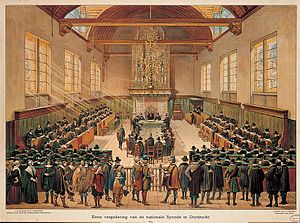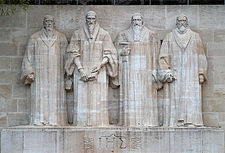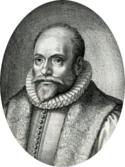Synod of Dort
The Synod of Dort (also known as the Synod of Dordt or the Synod of Dordrecht) was a European transnational
In 2014, the first entire critical edition of the Acts and Documents of the Synod was published.[1]
Background
There had been previous provincial synods of Dort, and a National Synod in 1578.[2] For that reason the 1618 meeting is sometimes called the Second Synod of Dort.
The acts of the Synod were tied to political intrigues that arose during the
The Arminians were accused of propagating false doctrine and perceived as ready to compromise with the Spanish, whereas the Dutch
Purpose
The purpose of the Synod was to settle the controversy over Arminianism. It was subsequently alleged, but never proven, that the outcome had already been decided. According to Frederick Calder, "condemnation [of the Remonstrant doctrines] was determined before the national synod met."[6] On the other hand, beyond the condemnation of the Arminians, the theological formulations of the Canons of the Synod by no means gave support to all the Gomarists wanted. In fact, Johannes Bogerman, president of the synod, himself a Supralapsarian, argued for the inclusion of the Infralapsarian position in the Canons. The more extreme views of Dutch Calvinists were moderated in the detailed debates.[7]
Delegates

The Synod had members representing
Proceedings
Simon Episcopius (1583–1643) was spokesman of the 14 Remonstrants who were summoned before the Synod in 1618. At the opening of the synod, Episcopius asked to speak.
Episcopius ... insisted on being permitted to begin with a refutation of the Calvinistic doctrines, especially that of reprobation, hoping that, by placing his objections to this doctrine in front of all the rest, he might excite such prejudice against the other articles of the system, as to secure the popular voice in his favor. The Synod, however, very properly, reminded him ... that, as the Remonstrants were accused of departing from the Reformed faith, they were bound first to justify themselves, by giving Scriptural proof in support of their opinions. The Arminians would not submit to this plan of procedure because it destroyed their whole scheme of argument ... and were thus compelled to withdraw. Upon their departure, the Synod proceeded without them.[10]
He concluded by expressing his dissatisfaction with the organization of the assembly, and that the Contra-Remonstrants had prevented an accurate representation of the Arminian supporters in the Dutch Reformed Church with votes in the synod.[11] A delegation of Episcopius consisting of Bernard Arentsz Dwinglo (1582–1652) and Johannes Arnoldi Corvinus called on the Church of England representatives, and others coming from outside, asking for support and giving written accounts of the context. After that a month was spent on procedural matters concerning the Remonstrants. They were finally ejected from the Synod at session 57 on 14 January.[12]
The Canons of Dort
| Part of a series on |
| Reformed Christianity |
|---|
 |
|
|
The Synod concluded with a rejection of the Arminian views, and set forth the Reformed doctrine on each point, namely:
a judgment, in which both, the true view agreeing with God's word concerning the aforesaid five points of doctrine is explained and, the false view disagreeing with God's Word is rejected.
Aftermath
The thirteen Remonstrant ministers, including Episcopius, had been charged to remain in Dort until further instruction. On 20 May 1619 the Remonstrant ministers who had been present were summoned by the lay-commissioners of the synod and directed to abstain from ministerial activities such as preaching, exhorting, administering the sacraments, and visiting the sick. Furthermore, Episcopius was commanded not to write letters or books promoting the doctrines of the Remonstrants. The Remonstrants agreed to refrain from ministering in the government-ordained churches, but confessed their duty to expound their doctrines wherever people would assemble to hear them.[14]
On 5 July they were called to the States-General assembly where they were requested to sign The Act of Cessation, the legalization of the order to desist from the ministry. When they refused to sign it, they were sentenced as "disturbers of the public peace" and ordered to leave the United Provinces.[15] However, in the 18th century, Arminian theology spread to England where it became integral to the theology of the Methodist churches.[16]
Bible translation
The synod also initiated an official Dutch Bible translation (the
Like its sister translations, the Genevan Bible and the King James Version (Authorized Version), the Dutch pastor-scholars worked in the Old Testament from the Masoretic Text (consulting the Septuagint) and in the New Testament from the Textus Receptus (consulting the Majority Text).
In 1645, the Westminster Assembly appointed Theodore Haak to translate the Statenvertaling met kanttekeningen (The Dort Bible and its Commentary) into English for wider distribution. This work was published by Henry Hill in London 1657.
Political impact
The Synod rejected the teachings of the Remonstrants on the controverted points as falling outside the bounds of the Reformed confessions. There followed the political condemnation of the statesman Johan van Oldenbarnevelt who had been the protector of the Remonstrants. For the crime of general perturbation in the state of the nation, both in Church and State (treason), he was beheaded on 13 May 1619, only four days after the final meeting of the Synod. As consequence of the Arminian defeat, the jurist Hugo Grotius was given a life sentence in prison; but he escaped with the help of his wife. Both Van Oldenbarnevelt and Grotius had in fact been imprisoned since 29 August 1618.
See also
Notes
- ^ Sinnema, Moser & Selderhuis 2015.
- ^ Select Acts from the Synod of Dordrecht, 3–18 June 1578; Translated from the edition of Acta published by W. van 't Spijker, 'Acta synode van Dordrecht (1578)', in: De nationale synode van Dordrecht 1578 ed. D. Nauta et al. (Amsterdam, 1978) 142–84
- ^ Israel 1982, pp. 62–63.
- ^ Israel 1998, p. 456.
- ^ Milton 2005, p. 2.
- ^ Calder 1835, pp. 270–271.
- ^ Patterson 2000, p. 260, Ch. 8 The Synod of Dort.
- ^ The British Delegation and the Synod of Dort (1618–1619) (Church of England Record Society), 2005
- ^ Horton 2011, p. 562.
- ^ Scott 1856, p. 5.
- ^ Calder 1835, p. 311: See Chapter X for Episcopius's entire oration and chapter XI on the proceedings of the synod.
- ^ Milton 2005, pp. 147–148.
- ^ Peterson & Williams 2004, p. 124.
- ^ Calder 1835, pp. 388–389.
- ^ Calder 1835, p. 389.
- ^ Olson 2009, p. 14: Arminian theology was at first suppressed in the United Provinces (known today as the Netherlands) but caught on there later and spread to England and the American colonies, largely through the influence of John Wesley and the Methodists
References
- Calder, Frederick (1835). Memoirs of Simon Episcopius. London: Simpkin and Marshall.
- ISBN 978-0-310-28604-2.
- ISBN 978-0-19-826534-4.
- ISBN 978-0-19-820734-4.
- Milton, Anthony (2005). The British Delegation and the Synod of Dort (1618-1619). Boydell Press. ISBN 978-1-84383-157-0.
- Olson, Roger E. (2009). Arminian Theology: Myths and Realities. InterVarsity Press. ISBN 978-0-8308-7443-9.
- Patterson, W. B. (2000). King James VI and I and the Reunion of Christendom. Cambridge: University Press. ISBN 978-0-521-79385-8.
- Peterson, Robert A.; Williams, Michael D. (2004). Why I Am Not an Arminian. InterVarsity Press. ISBN 978-0-8308-3248-4.
- Scott, Thomas (1856). The Articles of Synod of Dort. Philadelphia: Presbyterian Board of Publication. p. 5.
- Sinnema, Donald; Moser, Christian; ISBN 978-3-525-55078-6.
Further reading
- Brown Patterson, W. (1990). 'The Synod of Dort and the Early Stuart Church' [i.e., the Church of England], This Sacred History: Anglican Reflections, [festschrift] for John Booty, ed. Donald S. Armentrout (Cambridge, Massachusetts: Cowley Publications), p. 199-221. ISBN 1-56101-003-0
- Hoeksema, Homer C., The Voice of Our Fathers: an Exposition of the Canons of Dordrecht. Second ed. (Jenison, Mich.: Reformed Free Publishing Association, 2013). N.B.: The publisher's first ed. appeared in 1980. ISBN 978-1-936054-26-8
- Lieburg, Fred van. The Synod of Dordrecht, 1618–1619 (Dordrecht: Historisch Platform Dordrecht, 2017) (also published in Dutch and German)
- Rockwell, William Walker (1911). . In Chisholm, Hugh (ed.). Encyclopædia Britannica. Vol. 8 (11th ed.). Cambridge University Press.
External links
- Canons of Dort at the Wayback Machine (archived 2008-08-21) at CRC home
- Canons of Dort at Reformed.org
- The Ivdgement of the Synode Holden At Dort

